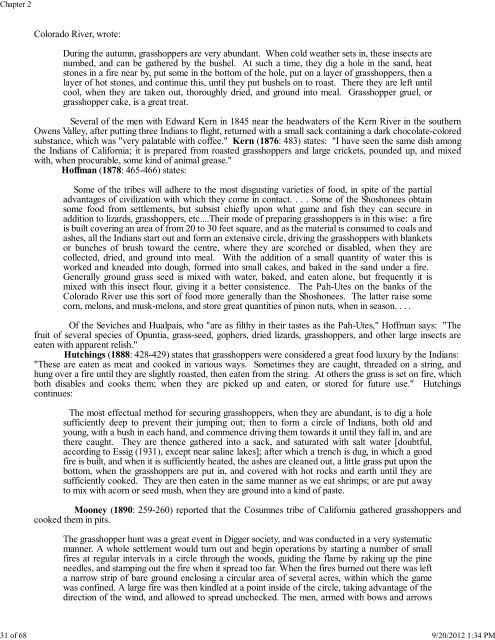Chapter 2. Insect Foods of North American Indigenous Populations ...
Chapter 2. Insect Foods of North American Indigenous Populations ...
Chapter 2. Insect Foods of North American Indigenous Populations ...
Create successful ePaper yourself
Turn your PDF publications into a flip-book with our unique Google optimized e-Paper software.
<strong>Chapter</strong> 231 <strong>of</strong> 68 9/20/2012 1:34 PMColorado River, wrote:During the autumn, grasshoppers are very abundant. When cold weather sets in, these insects arenumbed, and can be gathered by the bushel. At such a time, they dig a hole in the sand, heatstones in a fire near by, put some in the bottom <strong>of</strong> the hole, put on a layer <strong>of</strong> grasshoppers, then alayer <strong>of</strong> hot stones, and continue this, until they put bushels on to roast. There they are left untilcool, when they are taken out, thoroughly dried, and ground into meal. Grasshopper gruel, orgrasshopper cake, is a great treat.Several <strong>of</strong> the men with Edward Kern in 1845 near the headwaters <strong>of</strong> the Kern River in the southernOwens Valley, after putting three Indians to flight, returned with a small sack containing a dark chocolate-coloredsubstance, which was "very palatable with c<strong>of</strong>fee." Kern (1876: 483) states: "I have seen the same dish amongthe Indians <strong>of</strong> California; it is prepared from roasted grasshoppers and large crickets, pounded up, and mixedwith, when procurable, some kind <strong>of</strong> animal grease."H<strong>of</strong>fman (1878: 465-466) states:Some <strong>of</strong> the tribes will adhere to the most disgusting varieties <strong>of</strong> food, in spite <strong>of</strong> the partialadvantages <strong>of</strong> civilization with which they come in contact. . . . Some <strong>of</strong> the Shoshonees obtainsome food from settlements, but subsist chiefly upon what game and fish they can secure inaddition to lizards, grasshoppers, etc....Their mode <strong>of</strong> preparing grasshoppers is in this wise: a fireis built covering an area <strong>of</strong> from 20 to 30 feet square, and as the material is consumed to coals andashes, all the Indians start out and form an extensive circle, driving the grasshoppers with blanketsor bunches <strong>of</strong> brush toward the centre, where they are scorched or disabled, when they arecollected, dried, and ground into meal. With the addition <strong>of</strong> a small quantity <strong>of</strong> water this isworked and kneaded into dough, formed into small cakes, and baked in the sand under a fire.Generally ground grass seed is mixed with water, baked, and eaten alone, but frequently it ismixed with this insect flour, giving it a better consistence. The Pah-Utes on the banks <strong>of</strong> theColorado River use this sort <strong>of</strong> food more generally than the Shoshonees. The latter raise somecorn, melons, and musk-melons, and store great quantities <strong>of</strong> pinon nuts, when in season. . . .Of the Seviches and Hualpais, who "are as filthy in their tastes as the Pah-Utes," H<strong>of</strong>fman says: "Thefruit <strong>of</strong> several species <strong>of</strong> Opuntia, grass-seed, gophers, dried lizards, grasshoppers, and other large insects areeaten with apparent relish."Hutchings (1888: 428-429) states that grasshoppers were considered a great food luxury by the Indians:"These are eaten as meat and cooked in various ways. Sometimes they are caught, threaded on a string, andhung over a fire until they are slightly roasted, then eaten from the string. At others the grass is set on fire, whichboth disables and cooks them; when they are picked up and eaten, or stored for future use." Hutchingscontinues:The most effectual method for securing grasshoppers, when they are abundant, is to dig a holesufficiently deep to prevent their jumping out; then to form a circle <strong>of</strong> Indians, both old andyoung, with a bush in each hand, and commence driving them towards it until they fall in, and arethere caught. They are thence gathered into a sack, and saturated with salt water [doubtful,according to Essig (1931), except near saline lakes]; after which a trench is dug, in which a goodfire is built, and when it is sufficiently heated, the ashes are cleaned out, a little grass put upon thebottom, when the grasshoppers are put in, and covered with hot rocks and earth until they aresufficiently cooked. They are then eaten in the same manner as we eat shrimps; or are put awayto mix with acorn or seed mush, when they are ground into a kind <strong>of</strong> paste.Mooney (1890: 259-260) reported that the Cosumnes tribe <strong>of</strong> California gathered grasshoppers andcooked them in pits.The grasshopper hunt was a great event in Digger society, and was conducted in a very systematicmanner. A whole settlement would turn out and begin operations by starting a number <strong>of</strong> smallfires at regular intervals in a circle through the woods, guiding the flame by raking up the pineneedles, and stamping out the fire when it spread too far. When the fires burned out there was lefta narrow strip <strong>of</strong> bare ground enclosing a circular area <strong>of</strong> several acres, within which the gamewas confined. A large fire was then kindled at a point inside <strong>of</strong> the circle, taking advantage <strong>of</strong> thedirection <strong>of</strong> the wind, and allowed to spread unchecked. The men, armed with bows and arrows
















